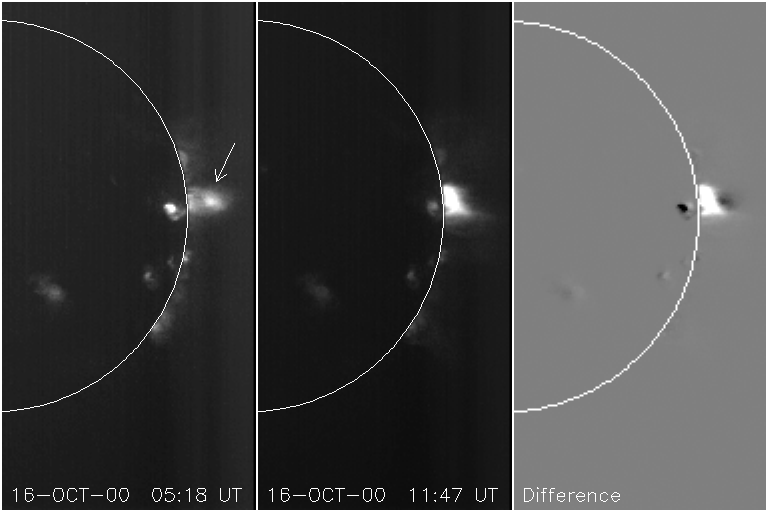
Introduction
Please refer to last week's science nugget for background information here. This is the second nugget on the same complex event, which began with a flare feature a limited ejection and a superhot source, and proceeded to a bigger event with a CME. This sequence of events took place October 16, 2000, following the rotation off the W limb of NOAA active region 9182. Here is a movie of the CME (beware, it's 777 kB) borrowed from the very convenient Catholic University CME catalog of LASCO observations.
A novel dimming
In the image below the three panels show the following: left, a post-flare loop system marked by an arrow; right, the aftermath of the major flare event at 07:00, a spiky arcade associated with a spectacular CME; and right, a difference image. Please refer to the GOES soft X-ray flux for a time history of the events, making liberal references to last week's science nugget

Why is this novel? It is because the post-flare loop system seems to have been blown away by the CME. Otherwise, with the long cooling times associated with these large structures, it still would have been there. In spite of the violence of CME's and their aptly-named "global restructuring" events in the lower corona, we often see the rest of the corona blithely ignoring what looks like a catastrophic disruption. The CME movie shows this phenomenon well enough in this case, in the sense that one half of the corona doesn't seem to know what the other half is doing, in spite of the presumed linkage through magnetic forces. We have also remarked in other science nuggets on this curious ability of the corona to remain unperturbed. If this disruption of a post-flare loop system could be confirmed in a better-observed case, preferably on the disk, it would help us a great deal to understand the energetics of CMEs.
The dimming, close-up
In this case we were lucky to have action recorded in the partial-frame images of the Yohkoh flare mode. The difference pair below shows shows the features of interest in frames 10 arc min across:

The two images show the end of the first flare, as reported in last week's nugget, and an image from the onset phase of the second flare. By this time the blow-off has happened and the CME is well on its way (SXT, 06:43 UT; C2, 07:27 UT, C3, 07:42 UT in proper sequence) We see
What have we learned?
The sequence of events presented in these two science nuggets had several novelties: first, a superhot source with rapid fluctuations (this needs analysis!) accompanied a partial ejection, with no coronal manifestations; second, hot on the heels of this, a second event with massive coronal effects did take place. This latter event took the unprecedented liberty of blowing away a post-flare loop system, normally the most stable and benign of coronal creatures, thought generally to be the result of placidly proceeding magnetic reconnection following the flare explosion itself.